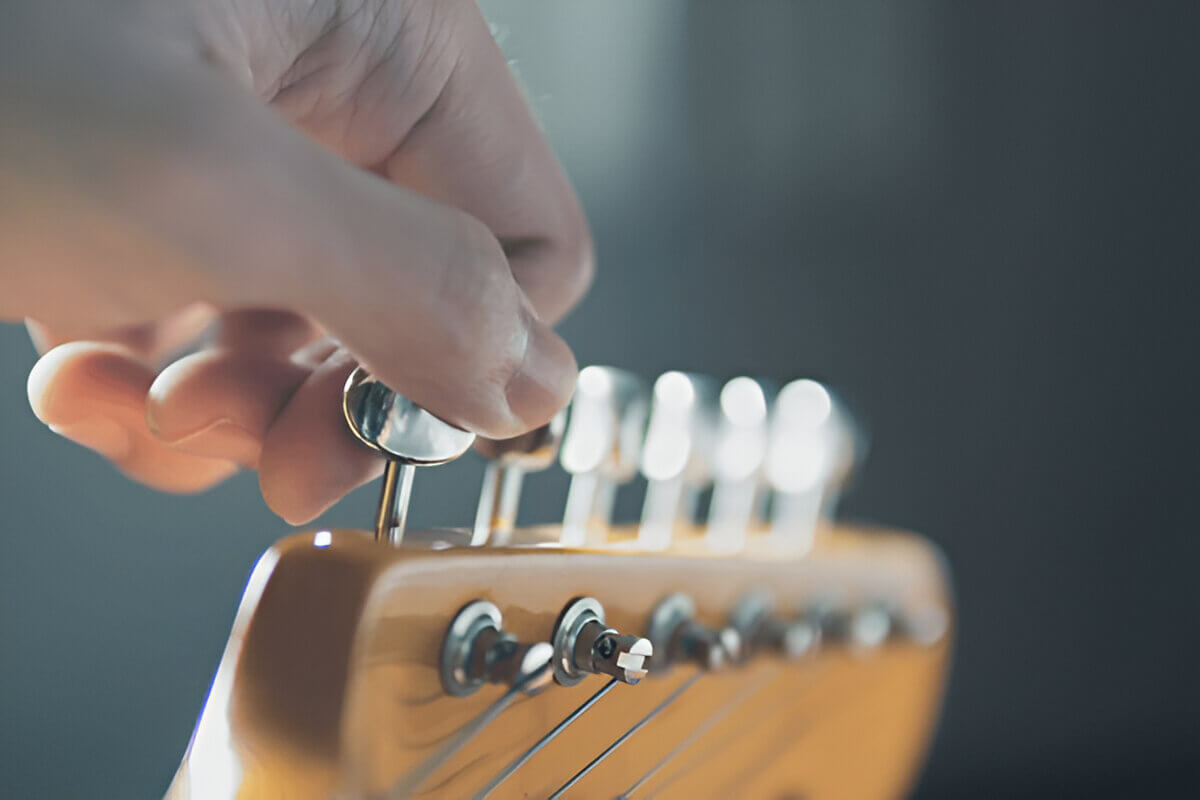
Tuning a guitar is essential for musicians, especially beginners. It enhances music quality and develops a keen ear for pitch. This guide covers standard tuning (EADGBE) and methods like electronic tuners or tuning by ear. It also addresses common challenges in maintaining pitch with practical solutions. Whether playing acoustic or electric, mastering these techniques ensures your guitar always sounds its best.
Why Proper Guitar Tuning is Crucial for Every Musician
Proper guitar tuning is a fundamental aspect of musicianship that every guitarist, from beginners to seasoned players, should prioritize. The importance of guitar tuning cannot be overstated, as it directly influences the quality of sound and overall performance. For those new to playing, beginner guitar tips often emphasize the necessity of learning how to tune your instrument accurately.
One of the primary benefits of tuning a guitar is ensuring that each note you play resonates correctly, providing a harmonious and pleasing sound. This is particularly crucial for acoustic guitars, where the natural resonance can be significantly affected by even minor discrepancies in tuning. Proper acoustic guitar tuning allows for the full expression of the instrument’s tonal qualities, enhancing both practice sessions and performances.
Furthermore, maintaining correct tuning aids in developing a musician’s ear. Regularly adjusting your strings trains you to recognize when something sounds off-key, which is an invaluable skill for any musician. By incorporating regular tuning into your routine, you not only improve your playing experience but also lay a solid foundation for future musical growth and exploration.
The Standard Tuning for Guitars

When embarking on your journey to learn guitar, one of the first concepts you’ll encounter is standard guitar tuning. This foundational tuning method, known as EADGBE tuning, is essential for new players to grasp as it forms the basis for most music played on the guitar.
Standard guitar tuning arranges the strings in a specific order from the thickest to the thinnest: E, A, D, G, B, and E. These notes are referred to as basic guitar notes and are critical for playing chords and melodies accurately. Each string has a name corresponding to its pitch when played open (without pressing any frets).
Understanding these guitar string names not only helps in learning scales and chords but also aids in effective communication with other musicians. Mastering this standard tuning is your first step toward unlocking a world of musical possibilities on your instrument. Whether you’re strumming simple tunes or diving into complex compositions, knowing EADGBE tuning ensures you’re always starting from a solid foundation.
The Different Methods to Tune Your Guitar
Tuning your guitar is an essential skill for any guitarist, ensuring that your instrument produces the best possible sound. There are several methods to achieve this, each with its own advantages.
One of the most convenient ways to tune your guitar is by using a **guitar tuner app**. These apps are widely available for smartphones and offer a quick and easy solution for tuning on the go. They typically use your device’s microphone to detect the pitch of each string and guide you to adjust them until they are perfectly in tune.
For those who prefer a more traditional approach, learning how to tune by ear can be incredibly rewarding. This method involves listening carefully to each string and adjusting them relative to one another, often starting with a reference pitch like an A440 tuning fork or another instrument. Tuning by ear helps develop your musical ear and can be done without any external tools.
Another popular option is using a digital tuner, which provides precise readings of each string’s pitch through visual indicators such as LEDs or LCD screens. Digital tuners come in various forms, including clip-on models that attach directly to the guitar headstock or pedal units used in live performances.
Lastly, there are numerous online tuner tools available that function similarly to apps but can be accessed via web browsers on computers or tablets. These tools offer flexibility for those who may not have access to dedicated devices or prefer working from their desktops.
Each method has its unique benefits, catering to different preferences and situations, ensuring you always have access to perfectly tuned strings no matter where you are or what resources you have at hand.
Step-by-Step Guide on How to Tune a Guitar with an Electronic Tuner
Tuning a guitar can seem daunting for beginners, but using an electronic tuner simplifies the process significantly. This step-by-step tuning guide will walk you through the basics of using an electronic tuner, ensuring your guitar sounds its best.
First, ensure your electronic tuner is properly powered and calibrated. Most tuners are set to A440 Hz by default, which is standard tuning. Begin by turning on your tuner and selecting the ‘guitar’ mode if available.
Next, position yourself in a quiet environment to avoid interference from background noise. Start with the low E string (the thickest string). Pluck it gently and observe the tuner’s display. The goal is for the needle or indicator light to align with the center mark, signaling that the string is in tune.
If the indicator shows that you’re flat (below pitch), tighten the tuning peg slowly until you reach pitch. Conversely, if you’re sharp (above pitch), loosen it slightly. Repeat this process for each string: A, D, G, B, and finally high E.
Remember to check each string multiple times as adjusting one can affect others due to changes in tension across the neck. Once all strings are accurately tuned using your electronic tuner, strum a chord to ensure harmonious sound quality.
This beginner’s guide to tuners highlights how straightforward tuning can be with modern tools at hand, allowing even novice players to achieve professional-sounding results swiftly and effortlessly.
Tuning Your Guitar by Ear (Tips and Techniques for Accurate Pitching)
Tuning your guitar by ear is an invaluable skill that enhances your musicianship and deepens your understanding of pitch and harmony. While electronic tuners provide a quick fix, ear training for musicians can foster a more intuitive connection with your instrument. Here are some tips and techniques to help you tune without a tuner using manual methods.
Start by familiarizing yourself with the sound of each open string in standard tuning: E, A, D, G, B, and E. You can use a reference pitch from another instrument or a tuning fork to get started on the low E string. Once you have this reference note set accurately, use the fifth-fret method to tune the remaining strings. For instance, press down on the fifth fret of the low E string; this should match the open A string when both are in tune.
Another effective technique is harmonics tuning. By lightly touching above certain frets (typically 5th and 7th), you can produce harmonic tones that should match between strings if they’re properly tuned relative to each other.
Practicing these manual tuning techniques not only helps you develop better pitch recognition but also prepares you for situations where electronic tuners aren’t available. Over time, ear training will enable you to perceive subtle nuances in tone quality and intonation, making it easier to maintain accurate pitching during performances or jam sessions.
Troubleshooting Common Tuning Problems and How to Fix Them
When it comes to keeping your guitar sounding its best, troubleshooting tuning problems is a crucial skill for any guitarist. One common issue many players face is when their guitar won’t stay in tune. This can be frustrating, but understanding the root causes can help you address the problem effectively.
One of the primary reasons a guitar won’t stay in tune is loose strings. Over time, strings can stretch and lose their tension, leading to frequent retuning. To fix this issue, ensure that your strings are properly stretched after installation and consider replacing them if they’ve become too old or worn out.
Another common challenge is fixing intonation problems on a guitar. Intonation refers to how well your instrument stays in tune across the fretboard. If you notice that notes sound sharp or flat as you play higher up the neck, it might be time to adjust your intonation. This typically involves fine-tuning the position of the bridge saddles until each string plays perfectly in tune at both open and fretted positions.
By addressing these issues, you can significantly improve your guitar’s tuning stability and enjoy a more harmonious playing experience. Remember, regular maintenance and attention to detail are key to keeping your instrument in top playing condition.
The Impact of Environment on Your Guitar’s Tuning Stability
When it comes to maintaining your guitar’s tuning stability, environmental factors like humidity and temperature play a crucial role. Understanding how these elements affect your instrument can help you take proactive measures to preserve its sound quality and longevity.
Humidity is one of the primary environmental influences on guitars. Wood, being a hygroscopic material, absorbs and releases moisture based on the surrounding environment. High humidity levels can cause the wood to swell, leading to issues such as raised action and compromised tuning stability. Conversely, low humidity can dry out the wood, resulting in cracks or warping that also disrupts tuning.
Temperature changes are another significant factor affecting a guitar’s tuning stability. Fluctuations in temperature cause the wood to expand and contract, which can lead to shifts in intonation and tension across the strings. This is particularly problematic when moving between environments with different climate conditions, for example, taking your guitar from an air-conditioned room into warm outdoor air.
To mitigate these effects, consider using a humidifier or dehumidifier in your storage space to maintain optimal humidity levels (around 45-55%). Additionally, try to keep your guitar in a stable temperature environment whenever possible. By understanding how humidity effects on guitars and temperature changes influence your instrument’s performance, you can better safeguard its tuning stability for years of enjoyable playing.
